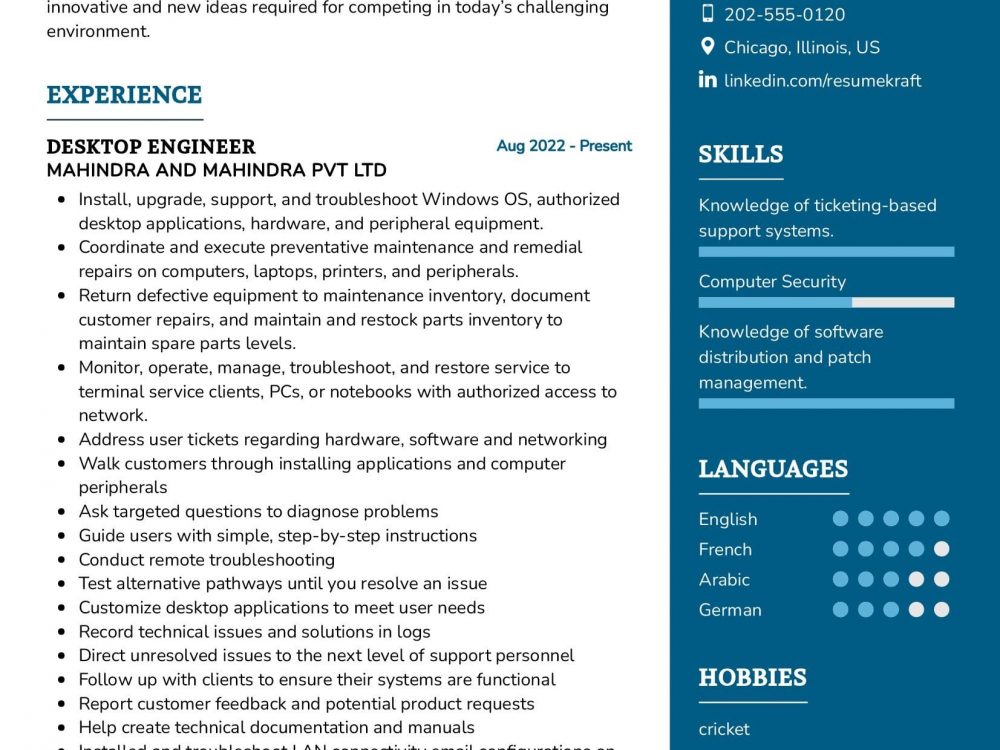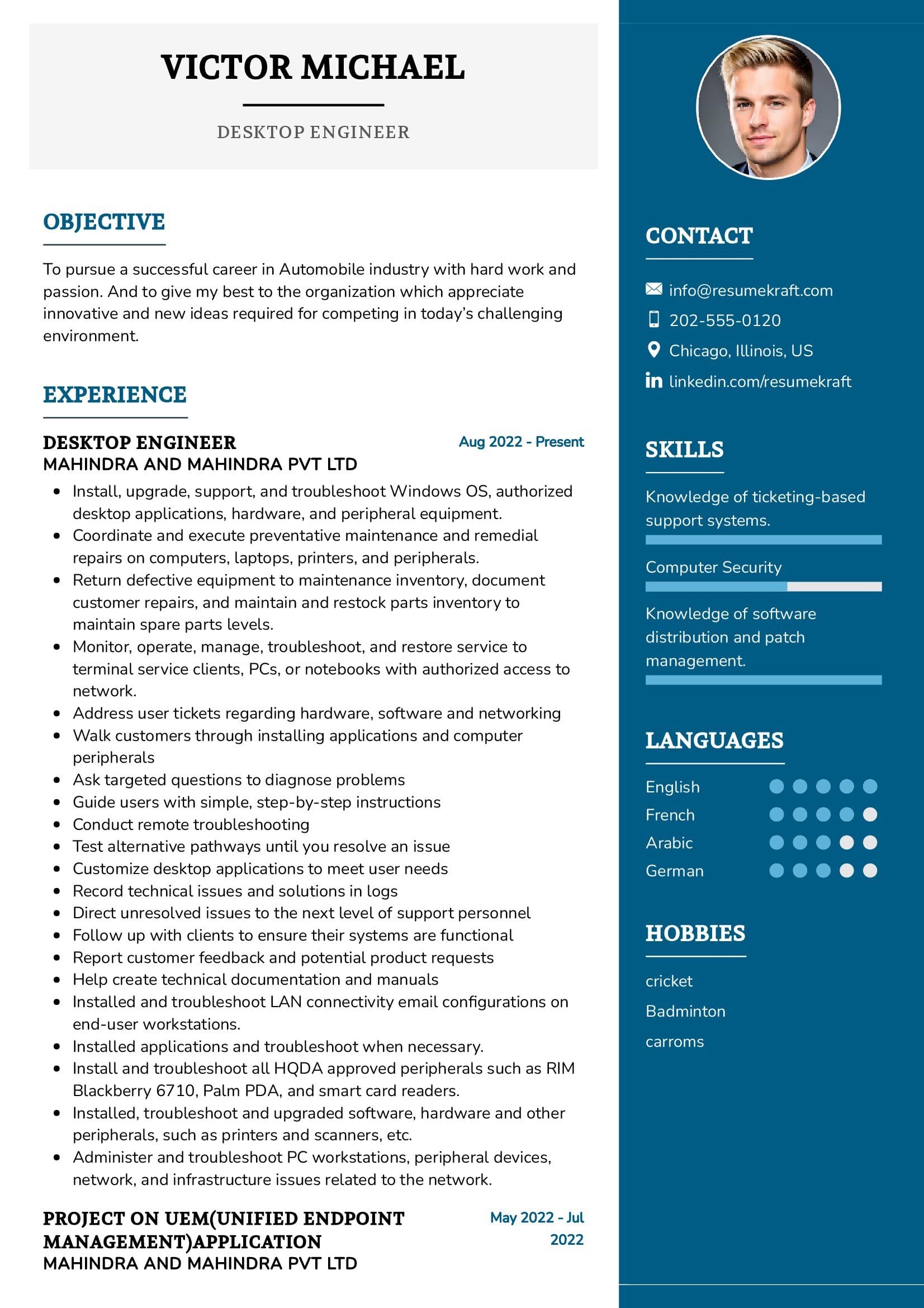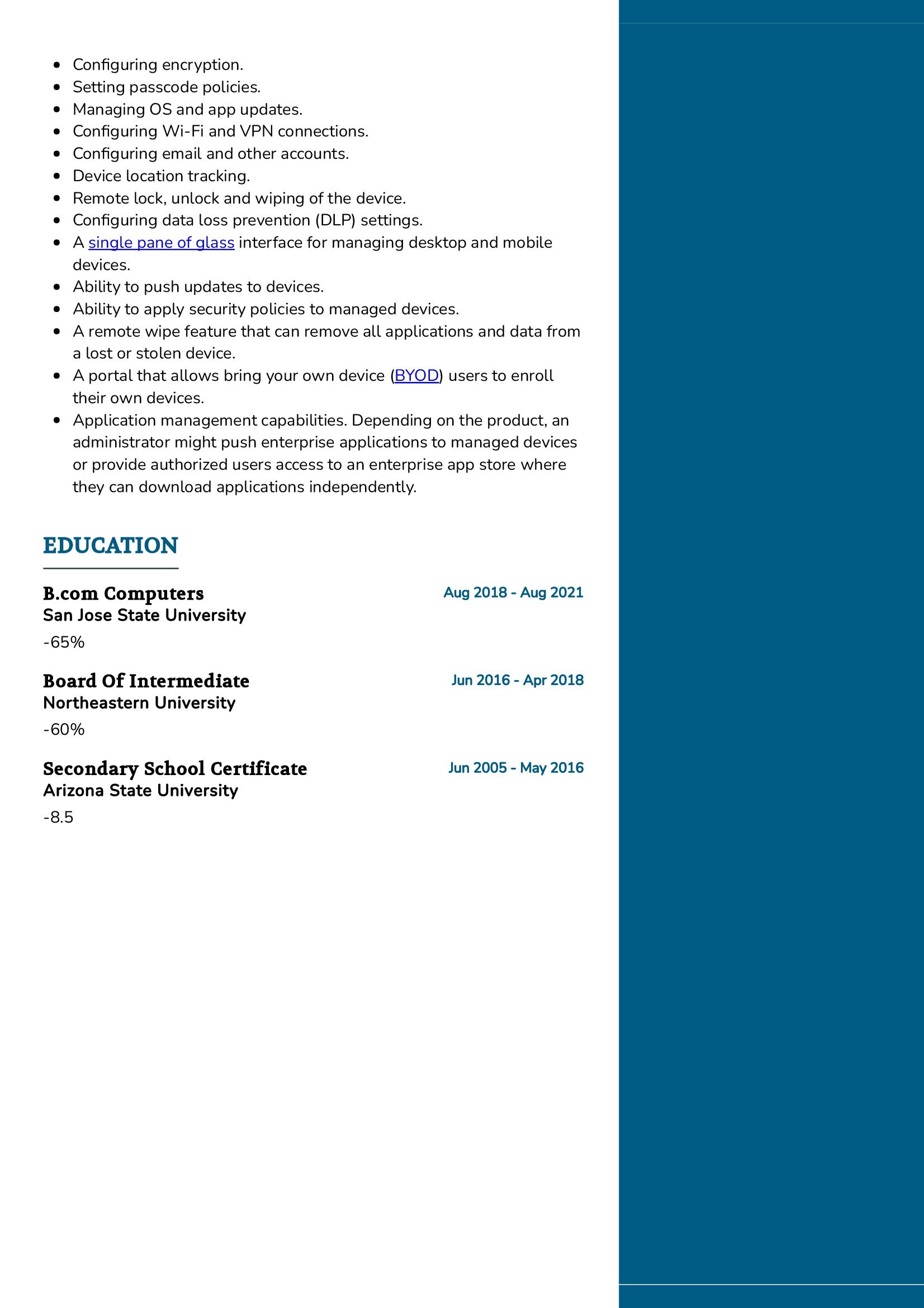The Role of a Desktop Engineer: Bridging Technology and Productivity
In today’s fast-paced digital landscape, the role of a Desktop Engineer is more crucial than ever before. As businesses and organizations rely heavily on technology to drive productivity and efficiency, Desktop Engineers play a pivotal role in ensuring that desktop systems and end-user computing environments run seamlessly. In this comprehensive guide, we’ll delve into the multifaceted role of a Desktop Engineer, the qualifications and skills required for the job, and provide valuable insights to help you craft a winning Desktop Engineer resume.
Desktop Engineer Job Requirements: Building the Foundation
Stepping into the role of a Desktop Engineer requires meeting a series of stringent requirements. It’s a journey that demands continuous learning and hands-on experience. Let’s explore the prerequisites that one needs to fulfill to excel as a Desktop Engineer:
- A Bachelor’s degree in Computer Science, Information Technology, or a related field, showcasing a strong foundation in the technical domain.
- Proficiency in operating systems such as Windows and macOS, with the ability to troubleshoot and resolve desktop-related issues.
- Experience in desktop support, demonstrating the ability to provide effective solutions to end-user problems.
- Knowledge of hardware components and peripherals, including desktops, laptops, printers, and mobile devices.
- Strong communication skills to interact with end-users and explain technical issues in a clear and understandable manner.
- Experience with remote desktop support tools and techniques, a valuable skill in today’s remote work environment.
- Attention to detail and problem-solving abilities, essential for diagnosing and resolving complex desktop issues.
Securing additional certifications in desktop support and IT management can significantly enhance your profile and competitiveness in the job market.
Responsibilities of a Desktop Engineer: Bridging Technology and End-Users
The role of a Desktop Engineer is a dynamic blend of technical expertise, problem-solving skills, and effective communication. Let’s delve into the core responsibilities that define this role, each contributing to a seamless end-user computing experience:
- Installing, configuring, and maintaining desktop operating systems and software applications.
- Providing technical support to end-users, addressing hardware and software issues promptly and efficiently.
- Managing and troubleshooting network connectivity problems, ensuring uninterrupted access to resources and services.
- Collaborating with IT teams to implement security protocols and measures to safeguard desktop systems and data.
- Proactively identifying and addressing potential desktop performance issues, optimizing systems for maximum efficiency.
- Developing and maintaining documentation for standard operating procedures, making it easier for end-users to resolve common issues independently.
- Assisting in desktop hardware and software procurement, ensuring compatibility and cost-effectiveness.
Each responsibility is a critical piece of the puzzle, contributing to a seamless and productive desktop computing environment.
Desktop Engineer Resume Writing Tips: Crafting Your Path to Success
Your resume is your gateway to securing a rewarding career as a Desktop Engineer. To stand out in a competitive job market, follow these tips to create a compelling resume:
- Highlight your technical expertise, showcasing your proficiency in desktop operating systems, hardware, and troubleshooting.
- Detail your experience in providing exceptional desktop support, emphasizing your ability to resolve end-user issues effectively.
- Include metrics to quantify your achievements, such as reducing downtime, improving response times, or enhancing system performance.
- List relevant certifications, demonstrating your commitment to continuous learning and professional development.
- Personalize your resume for each job application, aligning your skills and experiences with the specific requirements of the role.
Your resume is not just a document; it’s a reflection of your skills, knowledge, and dedication as a Desktop Engineer.
Desktop Engineer Resume Summary Examples: Your Opening Act
Your resume summary is your opportunity to make a strong first impression. Craft a powerful snapshot of your career journey and the value you bring as a Desktop Engineer:
- “Experienced Desktop Engineer with a proven track record in providing top-notch technical support, reducing system downtime by 30%, and ensuring seamless end-user experiences.”
- “Dedicated Desktop Engineer with expertise in configuring and maintaining desktop environments, adept at solving complex technical issues efficiently.”
- “Detail-oriented Desktop Engineer with a passion for optimizing desktop performance, improving system reliability, and enhancing end-user satisfaction.”
Your resume summary sets the tone for the rest of your resume, so make it impactful.
Create a Strong Experience Section for Your Desktop Engineer Resume
Your experience section is the heart of your resume, where you narrate your career journey. Here are some examples to guide you:
- “Managed a diverse range of desktop systems in a large organization, overseeing software installations, hardware upgrades, and system troubleshooting.”
- “Played a key role in the implementation of remote desktop support solutions, ensuring uninterrupted service delivery for remote workers.”
- “Led desktop hardware procurement projects, resulting in cost savings of 15% while ensuring the availability of quality equipment for end-users.”
Your experiences shape your expertise as a Desktop Engineer, so showcase them proudly.
Educational Background: The Foundation of Your Career
Your educational journey forms the basis of your career. Here’s how you can list your educational milestones:
- Bachelor of Science in Computer Science, XYZ University, a solid foundation in computer science principles and practices, 2016.
- Certified Desktop Support Technician (CDST), demonstrating your expertise in desktop support, 2017.
- Master of Information Technology Management, ABC University, a comprehensive program focusing on IT management and leadership, 2019.
Your education is a testament to your dedication to your field.
Desktop Engineer Skills: Your Toolbox for Success
Your skill set is your toolkit, equipped with a diverse range of tools honed over the years. Here are the essential skills for a Desktop Engineer:
Soft Skills:
- Effective communication, the ability to explain technical concepts to non-technical end-users.
- Problem-solving skills, the capacity to diagnose and resolve complex desktop issues.
- Attention to detail, crucial for performing meticulous system configurations.
- Customer service orientation, fostering positive interactions with end-users.
- Adaptability, the flexibility to keep pace with evolving desktop technologies.
Hard Skills:
- Proficiency in Windows and macOS operating systems, with the ability to troubleshoot and configure desktop environments.</li >
- Knowledge of desktop hardware components and peripherals, facilitating hardware maintenance and upgrades.
- Experience with remote desktop support tools, enabling efficient troubleshooting for remote users.
- Security awareness, understanding security best practices to protect desktop systems and data.
- IT certifications, such as CompTIA A+, Microsoft Certified Desktop Support Technician (MCDST), or ITIL, showcasing your technical expertise.
Each skill equips you to provide exceptional desktop support and drive end-user satisfaction.
Common Mistakes to Avoid When Writing a Desktop Engineer Resume: Paving the Path to Success
Avoid these common resume pitfalls to ensure your resume stands out:
- Using generic, one-size-fits-all resumes that fail to highlight your unique qualifications for each job application.
- Focusing solely on job duties without showcasing your accomplishments and impact in previous roles.
- Overlooking the importance of a well-crafted cover letter, a valuable tool for connecting with potential employers.
- Using technical jargon excessively, which may obscure your qualifications from non-technical hiring managers.
- Neglecting to proofread your resume, which can leave a negative impression on potential employers.
Avoiding these mistakes will help you craft a resume that truly reflects your capabilities as a Desktop Engineer.
Key Takeaways for Your Desktop Engineer Resume: Your Path to Success
As we conclude this comprehensive guide, remember these key takeaways when crafting your Desktop Engineer resume:
- Emphasize your technical expertise in desktop support and troubleshooting.
- Showcase your experience in providing effective solutions to end-user issues.
- Quantify your achievements to demonstrate your impact in previous roles.
- Include relevant certifications to highlight your commitment to professional development.
Now, it’s time to put your knowledge into action and create a winning resume that will open doors to exciting opportunities in the world of Desktop Engineering.
Finally, feel free to utilize resources like AI Resume Builder, Resume Design, Resume Samples, Resume Examples, Resume Skills, Resume Help, Resume Synonyms, and Job Responsibilities to create a standout application and prepare for the Desktop Engineer job interview.



